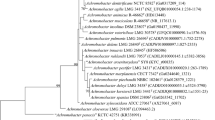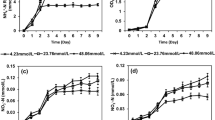Abstract
The marine nitrogen-fixing cyanobacterium Oscillatoria limosa, strain 23 (Oldenburg) was investigated with respect to its dark anaerobic metabolism. As soon as the cells were incubated anaerobically in the dark, they started to ferment. Glycogen was presumably degraded via the heterolactic fermentative pathway. Glycogen-glucose was degraded to equimolar amounts of lactate, ethanol and carbon dioxide. The disaccharide trehalose, which serves as an osmoprotectant in O. limosa, was also catabolized. Most probably, this compound was fermented almost exclusively to acetate. Some hydrogen was produced as well. In the presence of elemental sulfur, fermentative hydrogen production ceased and sulfide was produced instead. The presence of elemental sulfur had no effect on the amounts and ratios of the fermentation products produced.
Similar content being viewed by others
References
Allen MM (1984) Cyanobacterial cell inclusions. Ann Rev Microbiol 38:1–25
Ameyama M, Adachi O (1982) Alcohol dehydrogenase from acetic acid bacteria, membrane-bound. In: Wood WA (ed) Methods in enzymology, vol 89. Academic Press, New York, pp 450–457
Batterton JC, Baalen C van (1958) Phosphorus deficiency and phosphate uptake in the blue-green alga Anacystis nidulans. Can J Microbiol 14:341–348
Bottomley PJ, Stewart WDP (1976) The measurement and significance of ATP-pools in filamentous blue-green algae. Br Phycol J 11:69–82
Braunegg G, Sonnleitner B, Lafferty RM (1978) A rapid gas chromatographic method for the determination of poly-β-hydroxybutyric acid in microbial biomass Eur J Appl Microbiol Biotechnol 6:29–37
Calkins VP (1943) Microdetermination of glycolic and oxalic acids. Ind Eng Chem 15:762–763
Campbell J III, Stevens SE Jr, Balkwill DL (1982) Accumulation of poly-β-hydroxybutyrate in Spirulina platensis J Bacteriol 149:361–363
Carr NG (1966) The occurrence of poly-β-hydroxybutyrate in the blue-green alga Chlorogloea fritschii Biophys Acta 120:308–310
Chaney AL, Marbach EP (1962) Modified reagents for determination of urea and ammonia. Clin Chem 8:130–132
Dawes EA, Senior PJ (1973) The role and regulation of energy reserve polymers and microorganisms. Adv Microbiol Phys 10:135–266
Harold FM (1963) Accumulation of inorganic phosphate in Aerobacter aerogenes. I. Relationship to growth and nucleic acid synthesis. J Bacteriol 86:216–221
Hillier AJ, Jago GR (1982) L-Lactate dehydrogenase, FDP-activated, from Streptococcus cremoris. In: Wood WA (ed) Methods in enzymology, vol 89. Academic Press, New York, pp 362–367
Hoare DS, Ingram LO, Thurston EL, Walkup R (1971) Dark neterotrophic growth of an endophytic blue-green alga. Arch Mikrobiol 78:310–321
Höpner T, Ruschig U, Müller U, Willnow P (1982) Formate dehydrogenase from Pseudomonas oxalaticus. In: Wood WA (ed) Methods in enzymology, vol 89. Academic Press, New York, pp 531–534
Krzycki JA, Zeikus JG (1984) Characterization and purification of carbon monoxide dehydrogenase from Methanosarcina barkeri. J Bacteriol 158:231–237
Lang E, Lang H (1972) Spezifische Farbreaktion zum direkten Nachweis der Ameisensäure. Z Anal Chem 260:8–10
Lawry NH, Jensen TE (1979) Deposition of condensed phosphate as an effect of varying sulfur deficiency in the cyanobacterium Synechococcus sp. (Anacystis nidulans) Arch Microbiol 120: 7–10
Liere van L, Mur LR, Gibson CE, Herdman M (1979) Growth and physiology of Oscillatoria agardhii Gomont cultivated in continuous culture with a light-dark cycle. Arch Microbiol 123:315–318
Ljungdahl LG (1986) The autotrophic pathway of acetate synthesis in acetogenic bacteria Ann Rev Microbiol 40:415–450
McKinney G (1941) Absorption of light by chlorophyll solutions. J Biol Chem 140:315–322
Messineo L (1966) Modification of the Sakaguchi reaction: Spectrophotometric determination of arginine in proteins without previous hydrolysis. Arch Biophys Biochem 117:534–540
Murphy J, Riley JP (1962) A modified single solution method for the determination of phosphate in natural waters. Anal Chim Acta 27:31–36
Myers J, Kratz WA (1955) Relation between pigment content and photosynthetic characteristics in a blue-green alga. J Gen Physiol 39:11–22
Nakajima H, Suzuki K, Imahori K (1978) Purification and properties of acetate kinase from Bacillus stearothermophilus. J Biochem 84:193–203
Oren A, Shilo M (1979) Anaerobic heterotrophic dark metabolism in the cyanobacterium Oscillatoria limnetica: sulfur respiration and lactate fermentation. Arch Microbiol 122:77–84
Reed RH, Richardson DL, Warr SRC, Stewart WDP (1984) Carbohydrate accumulation and osmotic stress in cyanobacteria. J Gen Microbiol 130:1–4
Reed RH, Warr SRC, Richardson DL, Moore DJ, Stewart WDP (1985) Multiphasic osmotic adjustment in a euryhaline cyanobacterium. FEMS Microbiol Lett 28:225–229
Revsbech NP, Jørgensen BB, Blackburn TH, Cohen Y (1983) Microelectrode studies of the photosynthesis and O2, H2S and pH profiles of a microbial mat. Limnol Oceanogr 28:1062–1074
Richarson LL, Castenholz RW (1987) Enhanced survival of the cyanobacterium Oscillatoria terebriformis in darkness under anaerobic conditions. Appl Environment Microbiol 53:2151–2158
Rippka R, Deruelles J, Waterbury JB, Herdman M, Stanier RY (1979) Generic assignments, strain histories and properties of pure cultures of cyanobacteria. J Gen Microbiol 111:1–61
Roy AB, Trudinger PA (1970) The biochemistry of inorganic compounds of sulfur. University Press, Cambridge
Schimz K-L, Irrgang K, Overhoff B (1985) Trehalose, a cytoplasmic reserve disaccharide of Cellulomonas sp. DSM20108:its identification, carbon-source dependent accumulation, and degradation during starvation. FEMS Microbiol Lett 30:165–169
Schlegel HG, Steinbüchel A (1981) Die relative Respirationsrate (RRR), ein neuer Belüftungsparameter In: Lafferty RM (ed) Fermentation. Springer, Wien, pp 11–26
Schlegel HG, Vollbrecht D (1980) Formation of the dehydrogenase for lactate, ethanol and butanediol in the strictly aerobic bacterium Alcaligenes eutrophus. J Gen Microbiol 117:475–481
Shively JM (1974) Inclusion bodies of prokaryotes. Ann Rev Microbiol 28:167–187
Simon RD (1973) Measurements of the cyanophycin granule polypeptide contained in the blue-green alga Anabaena cylindrica. J Bacteriol 114:1213–1216
Smith AJ (1982) Modes of cyanobacterial carbon metabolism. In: Carr NG, Whitton BA (eds) The biology of cyanobacteria. Blackwell Sci Publ, London, pp 47–86
Stal LJ, Heyer H (1987) Dark anaerobic nitrogen fixation (acetylene reduction) in the cyanobacterium Oscillatoria sp. FEMS Microbiol Lett 45:227–232
Stal LJ, Krumbein WE (1981) Aerobic nitrogen fixation in pure cultures of a benthic marine Oscillatoria (cyanobacteria). FEMS Microbiol Lett 11:295–298
Stal LJ, Krumbein WE (1985) Nitrogenase activity in the non-heterocystous cyanobacterium Oscillatoria sp. grown under alternating light-dark cycles. Arch Microbiol 143:67–71
Stal LJ, Krumbein WE (1986) Metabolism of cyanobacteria in anaerobic marine sediments. Deuxième Colloque International de Bacteriologie marine, 1–5 Octobre 1986, Actes des Colloques 3:301–309 (Gerbam), Ifremer, Brest
Stal LJ, Reed RH (1987) Low-molecular mass carbohydrate accumulation in cyanobacteria from a marine microbial mat in response to salt. FEMS Microbiol Ecol 45:305–312
Stal LJ, Gemerden H van, Krumbein WE (1984) The simultaneous assay of chlorophyll and bacteriochlorophyll. J Microbiol Meth 2:295–306
Stanier RY, Cohen-Bazire G (1977) Phototrophic procaryotes: The cyanobacteria. Ann Rev Microbiol 31:225–274
Trevelyan WE, Harrison JS (1952) Studies on yeast metabolism. I. Fractionation and microdetermination of cell carbohydrates. Biochem J 50:298–303
Uyeda K, Rabinowitz JC (1971) Pyruvate-ferredoxin oxidoreductase. Purification and properties of the enzyme. J Biol Chem 246:3111–3119
Vollbrecht D, Schlegel HG, Stoschek G, Janczikowski A (1979) Excretion of metabolites by hydrogen bacteria. IV. Respiration rate-dependent formation of primary metabolites and of poly-3-hydroxybutanoate. Eur J Appl Microbiol Biotechnol 7:267–276
Author information
Authors and Affiliations
Rights and permissions
About this article
Cite this article
Heyer, H., Stal, L. & Krumbein, W.E. Simultaneous heterolactic and acetate fermentation in the marine cyanobacterium Oscillatoria limosa incubated anaerobically in the dark. Arch. Microbiol. 151, 558–564 (1989). https://doi.org/10.1007/BF00454875
Received:
Accepted:
Issue Date:
DOI: https://doi.org/10.1007/BF00454875




